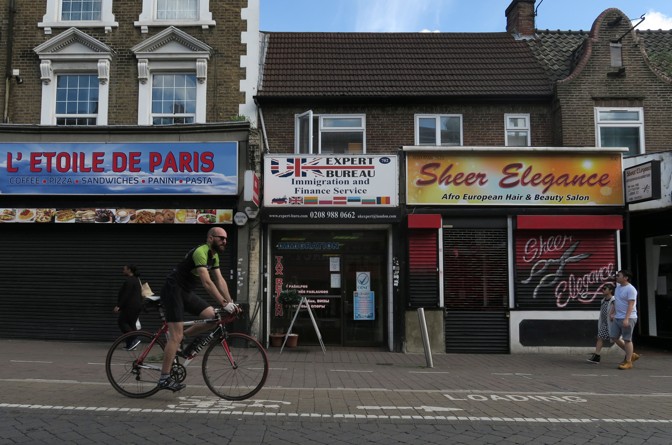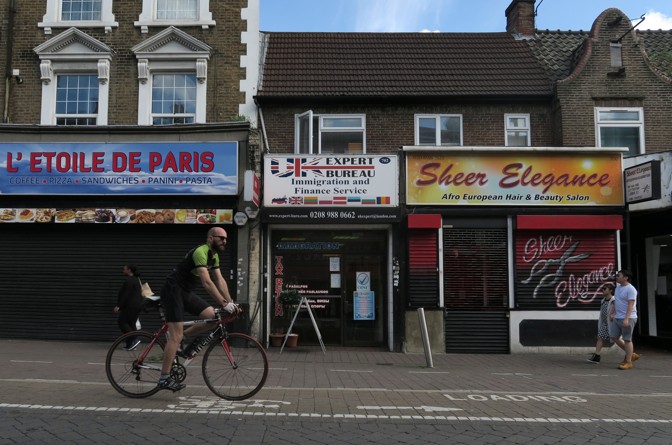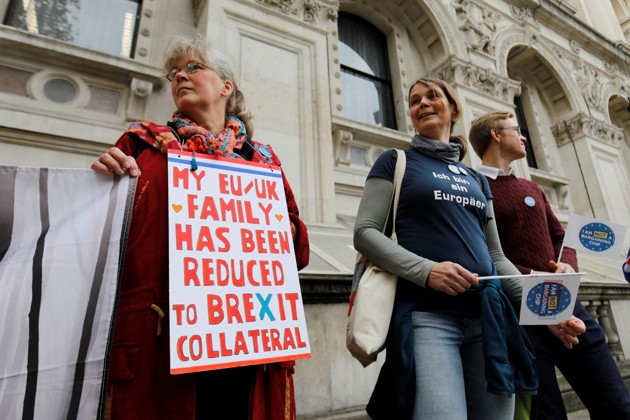
The U.S. Intelligence Community
Rebecca Goodall first moved to Britain when she was 10, and lived in the country on and off before settling here permanently in 2010. She teaches real estate at a university about two hours north of London, has a child who was born and raised here, and speaks unaccented English—she has, she told me in frustration, a “bloody master’s degree.”
But until recently, Goodall didn’t know if she could still live here.
As a German citizen, Goodall is among the millions of European Union nationals living in the U.K. whose immigration status was thrown into doubt after the 2016 Brexit referendum. Under the bloc’s rules, EU nationals can freely live, work, and settle anywhere across its 28 member states. Putting an end to this free flow of migration from Europe was one of the central planks of the Brexit debate and, now that Britain is leaving, all EU nationals who wish to remain in the country indefinitely need to apply for a new post-Brexit migration designation, otherwise known as “settled status.”
It won’t be easy, though. An estimated 3.5 million EU nationals are expected to apply for settled status over the next two years. It’s a massive undertaking—one of the largest and most ambitious migration exercises the British government has ever faced. It’s also, in the grand scheme of things, just one of a litany of bureaucratic challenges that London must address because of Brexit, from the seemingly minor (keeping food-supply chains going undisrupted) to the indisputably major (maintaining peace on the island of Ireland).
British Immigration Minister Caroline Nokes, who is overseeing the rollout of the EU Settlement Scheme, assured EU nationals that the process for them to stay would be “easy and straightforward,” and would allow them to continue their lives more or less as they do now. Still, some migration advocates fear that the sheer volume of applications could overwhelm the country’s ever-more antagonistic immigration regime—one that hasn’t exactly been known for its competence in recent years. Others worry that the most vulnerable EU nationals—such as the elderly, people with limited English, and even children—are at risk of being left behind.
[Read: The millions left marooned by Brexit]
When I first spoke with Goodall in January about her experience applying for settled status, she said she couldn’t help but feel nervous. “I’ve spent two and a half years stressing about this,” she told me by phone from her home in Derbyshire, in England’s East Midlands. “I feel like I’ve always been British, so to have to go through this process is emotionally demanding.”
Goodall first moved to the U.K. as a child with her family in 1990, and has lived here full-time since getting married in 2010. Speaking with her, you wouldn’t presume her to be anything but British—her unaccented English is only briefly betrayed when she switches into fluent German to talk to her mother.
Through her position as a senior lecturer teaching real-estate economics and valuation at Nottingham Trent University, she gained access to the the EU Settlement Scheme test phase, which was open to EU citizens working in select academic, health, and social-care institutions. The test phase in which Goodall took part received 30,000 applications and resulted in 27,211 decisions, with the remaining still pending as of January 14. Seventy percent received settled status. The rest were granted “pre-settled status,” a time-limited right to remain given to those who have lived in the country for less than the requisite five years. Those who receive pre-settled status must apply for settled status again once they have achieved the five-year requirement. Though European passport holders could begin applying as part of a wider public test phase as of January 21, the scheme’s full launch isn’t scheduled until March 30, regardless of when Britain leaves the EU. At that point, it will be open to all EU nationals (which, for scale, is more than 20 times the number of applicants who took part in the test phases so far). EU nationals will have until June 2021 to apply, though if Britain leaves the EU without a deal, the deadline will be moved to the end of 2020.

In practice, the process is simple: Applicants must first verify their identity using the British government’s “EU Exit: ID Document Check” mobile application, which uses facial-recognition and biometric software to scan the user’s photo and passport. Once that part is done, they must then complete their application online by submitting their National Insurance number (which is used to verify their work history and residency in the country) and criminal history. The whole process is estimated to take up to 20 minutes, though some say it took less than half that time.
For Goodall, it wasn’t so simple. First, there was the issue of her phone: The mobile application only works on newer Android devices so far. Like nearly half of all people in the U.K., she didn’t have an Android, nor did she know someone who did. When she eventually managed to borrow a phone from a colleague, the mobile app’s scanning function didn’t work, prompting her to mail her passport to the Home Office, the government department overseeing the process, for a manual check. After she submitted the rest of her information online, the system erroneously offered her pre-settled status because it recognized only two of the past five years she spent in the country—a lapse that Goodall surmised might have had to do with the gap in her employment history when she was on maternity leave. She had to submit additional proof of residence, such as utility bills and bank statements, to account for the missing years.
[Read: Welcome to the new Britain, where every week is hell]
Goodall finally got the news that she was granted indefinite leave to remain in January, nearly two months after she began her application. She said the process overall was “broadly positive,” but a far cry from the ease and simplicity she had expected. “This scheme has been marketed like it’s going to be 99 percent easy for people,” she said. “It wasn’t easy for me. I would bet money that it’s not going to be easy for my mum.” (Goodall’s mother, who is retired and disabled, also faced issues with the system, but after submitting additional documentation, she was granted indefinite leave to remain in early February.)
“I’ve got a bloody master’s degree and a professional qualification, and I found all of this quite taxing,” Goodall said.
Alexandra Bulat, who applied in the same test phase, faced similar issues proving her time spent here. Like Goodall, the scheme didn’t recognize her years of continuous residency, despite having lived in Britain since 2012, when she emigrated from Romania to attend university. “As a student working mainly part-time, temporary, and short-term contracts, I didn’t ever earn enough to pay income tax,” she told me.
Ultimately, though, Bulat said the experience was easier and less onerous than applying for permanent residency. After submitting additional documentation, she received an email confirming that she had been granted indefinite leave to remain the next day. “It was surprisingly quick,” she said.
Taken alone, processing millions of people like Goodall and Bulat—each of whom will likely face his or her own issues with the application—is a bureaucratic nightmare. Still, it’s merely one illustration of just how complex an undertaking Brexit is for Britain. Across the government, the country is facing the challenges of extricating itself from a 45-year relationship with the EU, from forging its own trade agreements (it has only agreed to continue a handful of the 40 trade deals it currently has as a member of the EU) to ensuring the flow of goods through its ports.
And with each of these challenges comes the added task of addressing their unintended consequences. What, for example, should EU nationals who don’t have an Android phone do to complete their application? Who will ensure that applicants such as the elderly and those who don’t speak English get the help they need?

In all, Goodall’s and Bulat’s experiences could be classified as success stories: They applied for settled status and, despite a few hiccups, ultimately achieved it. But if their experiences demonstrate just how difficult this process can be for EU citizens who have the documentation to prove that they’ve lived in the country continuously, they also show how impossible it can feel for those who don’t.
“This app is designed around a kind of stereotype of the ideal citizen: in work, contributing, present,” Maike Bohn, a co-founder of the3million, an advocacy group for EU citizens in the U.K., told me. “The people who will struggle are the people with intermittent records.”
Those who are self-employed or unemployed, stay-at-home parents, or elderly are among the groups that migration advocates like Bohn fear could be most at risk of falling through the cracks of this new system. British Future, a London-based migration think tank, warned in a January report that even a 5 percent rejection rate would render as many as 175,000 people undocumented, a crisis tantamount to last year’s Windrush scandal, in which thousands of migrants (this time from Britain’s former colonies in the Caribbean) were erroneously targeted with deportation orders as a result of the government’s “hostile environment” policies to clamp down on unwanted immigration. Dozens were wrongly removed. The Home Office’s track record of being heavy handed—and, in some cases, even cruel—in its immigration verdicts has spurred deep-seated mistrust in the department.
[Read: When even legal residents face deportation]
The government has taken steps to assist EU citizens with the application. In addition to setting up an email alert system (to which at least 300,000 people have so far subscribed, according to a Home Office spokesperson), the government has allocated £9 million ($11.7 million) to support voluntary and community organizations assisting vulnerable applicants. In an effort to ease the process further, Prime Minister Theresa May announced in January that the government would scrap the scheme’s £65 ($85) application fee.
But for those doing outreach on the ground, these efforts alone aren’t enough. Cristina Tegolo, an outreach coordinator for the3million, told me that many communities, such as the Roma, of which there are an estimated 300,000 people in the U.K., still aren’t aware of what they need to apply for settled status, or that they need to apply at all.
“They know nothing,” she said. “They know probably that Brexit is going to change something, but they still do not know about the application. They hardly speak any English.”
Among the biggest challenges is ensuring that applicants have a valid form of identification, such as a passport, and enough time to apply for one if they don’t. Another is access to the necessary technology: Not everyone has an Android phone, or someone to borrow one from. And though the Home Office has set up at least 27 document-scanning centers across the country to address this issue (with plans to open more than 50 after the scheme launches at the end of March), some are easier to get to than others. As of this writing, there is only one center, in Edinburgh, for the whole of Scotland, an area roughly the size of South Carolina. The closest center for applicants living in Liverpool is 34 miles away.
When I asked Tegolo whether she was confident that everyone would be able to apply, she did little to hide her pessimism. “It is a crisis in waiting,” she told me. “There are about 4,000 people that need to apply every day. The Home Office will be overwhelmed with applications.”
She paused, then added: “The system will collapse. This is what I think.”

 Ethicoin: Securing the Post-COVID-19 Future
Ethicoin: Securing the Post-COVID-19 Future  A Proclamation on National Crime Victims’ Rights, 2024
A Proclamation on National Crime Victims’ Rights, 2024 
